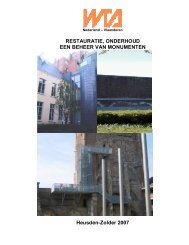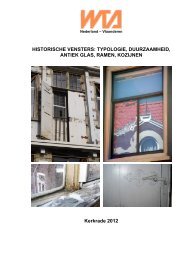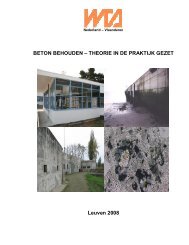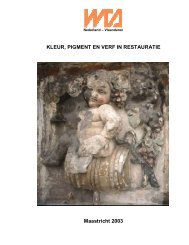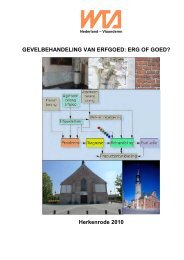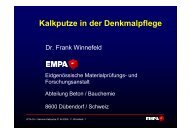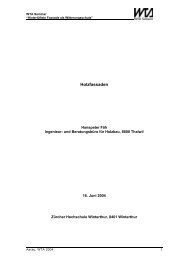MONUMENTEN EN WATER Diest 2005 - WTA
MONUMENTEN EN WATER Diest 2005 - WTA
MONUMENTEN EN WATER Diest 2005 - WTA
You also want an ePaper? Increase the reach of your titles
YUMPU automatically turns print PDFs into web optimized ePapers that Google loves.
structure can be supposed. Both explanations are likely to show up in the cumulative<br />
intrusion curve as a steep increase in porosity in the range of smaller pores. It is important to<br />
notice that the presence of very small pores determines the hygroscopicity of this plaster and<br />
increases its sensitivity to RH changes.<br />
Fig. 6: Pore size distribution of the brick substrate and of the plaster<br />
Point counting measurements have been performed on the thin section in order to study<br />
further the porosity. These measurements allow defining both closed and open porosity;<br />
because of the detection limit of the instrument, only pores larger than 1 μm can be<br />
detected. The closed porosity (due to the hollow spheres) constitutes 28 % of the area; voids<br />
and large pores amount to about 19 % of the surface. This last value is comparable to the<br />
porosity obtained by MIP when considering only pores larger than 1 μm.<br />
The pore size distribution of the material strongly influences its absorbing and drying<br />
behaviour (Figure 7). Because of the presence of small pores, the plaster shows a slow<br />
absorption and drying. Besides, the presence of the cellulose, that can retain water even in<br />
secondary moistening, explains the extremely slow drying of the restoration plaster.<br />
a<br />
Fig. 7: Water absorption (a) and drying rate (b) of the plaster<br />
- 6 -<br />
b





